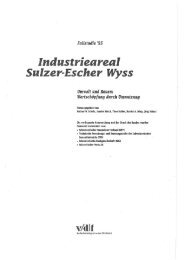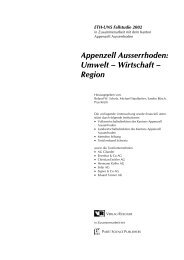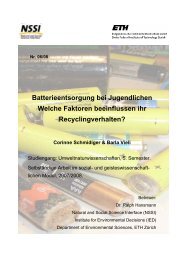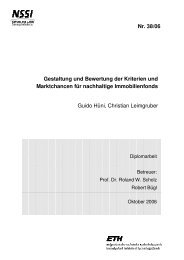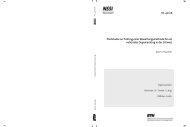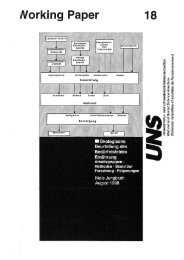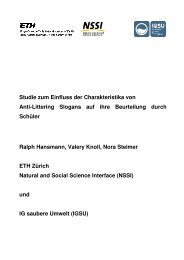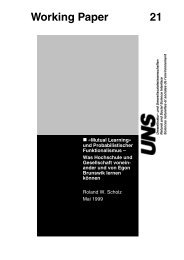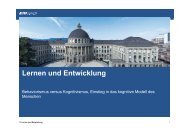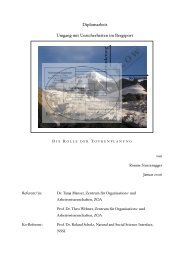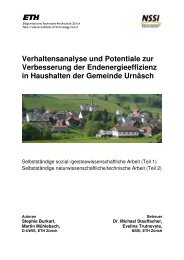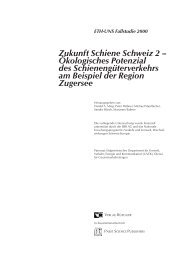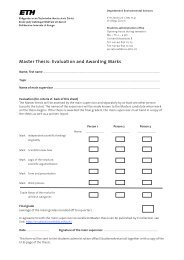Non-road fuel consumption and pollutant emissions ... - BAFU - CH
Non-road fuel consumption and pollutant emissions ... - BAFU - CH
Non-road fuel consumption and pollutant emissions ... - BAFU - CH
Create successful ePaper yourself
Turn your PDF publications into a flip-book with our unique Google optimized e-Paper software.
<strong>Non</strong>-<strong>road</strong> <strong>fuel</strong> <strong>consumption</strong> <strong>and</strong> <strong>pollutant</strong> <strong>emissions</strong> FOEN 2008 46<br />
6 > Inventories <strong>and</strong> operating hours<br />
of the individual machine categories<br />
6.1 Construction machinery<br />
The division of construction machines into sub-categories is largely based on the<br />
classification system used by CORINAIR. The figures concerning the inventory <strong>and</strong><br />
operating hours have been estimated by specialists in the workgroup using the data in<br />
the database of the Swiss Federal Vehicle Inspection Office <strong>and</strong> with the aid of an<br />
adjustment factor for non-registered machines. There are no official statistics other<br />
than those in the above database. The division by engine-power classes was carried out<br />
on the basis of available data, together with information provided by the manufacturers<br />
<strong>and</strong> the Swiss Association of Master Builders (SBV). The estimate of specific operating<br />
hours for individual machines was based on available literature (SBV 1999, IFEU<br />
2004), building <strong>and</strong> population statistics for Switzerl<strong>and</strong> (FSO 2002) <strong>and</strong> experience of<br />
specialists in the workgroup. Here, assumptions were made regarding the higher or<br />
lower degree of utilisation of construction machines, depending on the market situation.<br />
Inventory<br />
Figure 21 shows the inventory of construction machines by machine type (top left: only<br />
types with an inventory > 1000 machines) <strong>and</strong> engine-power class (top right). The largest<br />
group is stampers/vibrators (10,500 17 ), followed by compressors (8080) <strong>and</strong><br />
hydraulic excavators (8000). Three-quarters of construction machines are operated<br />
with diesel engines, while it is only stampers/vibrators <strong>and</strong> emergency power generators<br />
that primarily use petrol engines. In terms of engine power, the distribution of<br />
construction machines is fairly even among all engine-power classes up to 300 kW.<br />
Operating hours <strong>and</strong> their chronological development from 1980 to 2020<br />
The development of operating hours of construction machines by engine-power class<br />
<strong>and</strong> engine type is depicted in the lower half of Figure 21. Here the assumption is that,<br />
following a sharp increase in operating hours between 1980 <strong>and</strong> 1995, a slight decline<br />
in activity is to be expected in the next few years. At the same time, a shift takes place<br />
from small (petrol-powered) appliances to large diesel machines <strong>and</strong> in the direction of<br />
a rationalisation effect, i.e. the specific operating hours per machine increase (not<br />
apparent from the lower half of Fig. 21).<br />
17<br />
10,500 = 5650+1850+3000 (2-stroke <strong>and</strong> 4-stroke petrol plus diesel)



